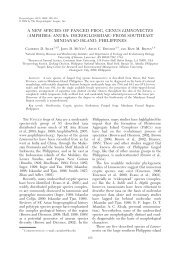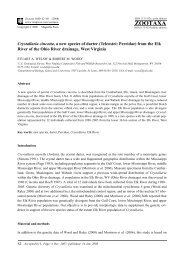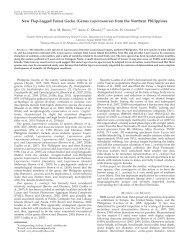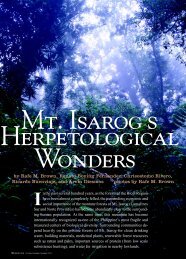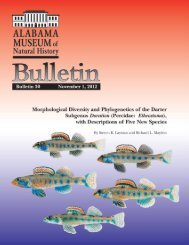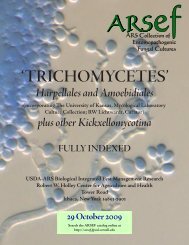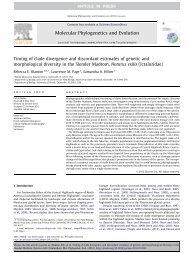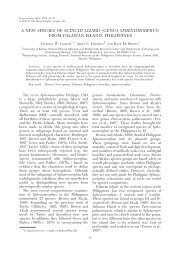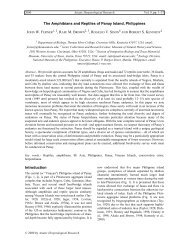Amphibian Conservation in the Philippines - Natural History Museum
Amphibian Conservation in the Philippines - Natural History Museum
Amphibian Conservation in the Philippines - Natural History Museum
You also want an ePaper? Increase the reach of your titles
YUMPU automatically turns print PDFs into web optimized ePapers that Google loves.
<strong>Amphibian</strong><br />
<strong>Conservation</strong> <strong>in</strong> <strong>the</strong><br />
Philipp<strong>in</strong>es<br />
Fig. 1: A substantial portion (~30–40%) of <strong>the</strong> total amphibian diversity of <strong>the</strong> Philipp<strong>in</strong>es may<br />
still be undescribed. Spectacular discoveries like this stream frog (Sanguirana aurantipunctata)<br />
are regular occurrences <strong>in</strong> recent years (16 ). Photo: Rafe M. Brown.<br />
By 1 Rafe M. Brown, 2 Arv<strong>in</strong> C. Diesmos, 3 Marites B. Sanguila, 1 Cameron D. Siler, 4 Mae L. D. Diesmos & 5 Angel C. Alcala<br />
The relatively small island archipelago of <strong>the</strong> Philipp<strong>in</strong>es<br />
shares only with Madagascar <strong>the</strong> dist<strong>in</strong>ction of be<strong>in</strong>g both a<br />
megadiverse nation and also a global conservation hotspot.<br />
This comb<strong>in</strong>ation of high concentrations of biodiversity, coupled<br />
with exceptionally high rates of forest loss and soar<strong>in</strong>g human population,<br />
places <strong>the</strong> country at <strong>the</strong> top of regional and global lists for<br />
conservation urgency and action. Among <strong>the</strong> top priorities for land<br />
vertebrate conservation <strong>in</strong> <strong>the</strong> Philipp<strong>in</strong>es are <strong>the</strong> country’s strik<strong>in</strong>gly<br />
diverse and highly endemic radiations of amphibians (1–4).<br />
Philipp<strong>in</strong>e amphibians<br />
The vast majority of Philipp<strong>in</strong>e amphibians occur nowhere else <strong>in</strong><br />
<strong>the</strong> world. Because <strong>the</strong>y are found <strong>in</strong> an archipelago of more than<br />
7,100 small islands, many Philipp<strong>in</strong>e amphibians have naturally<br />
restricted geographic ranges. This becomes a particular challenge<br />
when assess<strong>in</strong>g both amphibian species diversity and conservation<br />
status. With very small natural ranges (many endemic species<br />
occur on small islands, s<strong>in</strong>gle mounta<strong>in</strong> peaks, isolated limestone<br />
outcrops, etc.), Philipp<strong>in</strong>e species can be difficult to detect unless<br />
researchers visit <strong>the</strong> right place, at exactly <strong>the</strong> right time of year,<br />
1<br />
University of Kansas Biodiversity Institute, rafe@ku.edu, camsiler@<br />
ku.edu; 2 National <strong>Museum</strong> of <strong>the</strong> Philipp<strong>in</strong>es, arv<strong>in</strong>.diesmos@gmail.<br />
com; 3 Fa<strong>the</strong>r Saturn<strong>in</strong>o Urios University, maritesbonachita@yahoo.<br />
com; 4 University of Santo Tomas, maediesmos@yahoo.com; 5 Silliman<br />
University, suakcrem@gmail.com.<br />
40 | FrogLog 20 (5), Number 104 (October 2012)<br />
when atmospheric conditions are perfect. Because so many species<br />
have restricted ranges and reproductive patterns that are tightly<br />
coupled to local microclimates, many secretive species are poorly<br />
known—even to <strong>the</strong> most determ<strong>in</strong>ed of field biologists.<br />
L<strong>in</strong>naean and Wallacean shortfalls<br />
The challenge of unknown Philipp<strong>in</strong>e amphibians is exemplified<br />
by term<strong>in</strong>ology developed to describe our lack of understand<strong>in</strong>g of<br />
biodiversity at a global level (5). The L<strong>in</strong>naean shortfall (referr<strong>in</strong>g<br />
to our lack of knowledge of <strong>the</strong> existence of some species) <strong>in</strong> <strong>the</strong><br />
Philipp<strong>in</strong>e amphibians is represented <strong>in</strong> our sense that <strong>the</strong> country’s<br />
amphibian fauna may be underestimated by as much as a third<br />
of <strong>the</strong> total species diversity. The Wallacean shortfall (our lack of<br />
knowledge of species distributions) is evident <strong>in</strong> our woefully <strong>in</strong>complete<br />
understand<strong>in</strong>g of distributions of Philipp<strong>in</strong>e frogs, toads,<br />
and caecilians. Both deficiencies represent major stumbl<strong>in</strong>g blocks<br />
for effective conservation.<br />
A Philipp<strong>in</strong>e amphibian systematic and biogeographic<br />
agenda<br />
The amphibian fauna is composed of caecilians (three species <strong>in</strong><br />
two genera and one family) and anurans (with approximately 110<br />
species <strong>in</strong> 23 native genera <strong>in</strong> eight families). We now recognize a<br />
total of 110 native taxa, with exceptionally high endemism (85% of<br />
<strong>the</strong> native fauna)— <strong>the</strong> highest of endemism estimates of <strong>the</strong> Indo-
Fig. 2: Chytrid studies <strong>in</strong> <strong>the</strong> lab and field: (left) student participants at a recent WCSP chytridiomycosis workshop learn proper swabb<strong>in</strong>g technique with preserved museum<br />
specimens. (right) Vance Vredenburg, Viscente Yngente, and Jason Fernandez screen Laguna Prov<strong>in</strong>ce species (Rhacophorus pardalis, R. appendiculatus, Limnonectes<br />
woodworthi, L. macrocephalus, and Occidozyga laevis) for chytrid fungus <strong>in</strong> 2012. Photos: Rafe M. Brown.<br />
malayan realm (2). Efforts to arrive at a total, comprehensive estimate<br />
of Philipp<strong>in</strong>e amphibian diversity have gone through several<br />
discrete historical stages of species accumulation <strong>in</strong> <strong>the</strong> archipelago<br />
(4, 6, 7), correspond<strong>in</strong>g to <strong>the</strong> European age of Discovery (1800s),<br />
<strong>the</strong> works of E. H. Taylor (early 1900s), R. F. Inger (1950s), W. C.<br />
Brown and A. C. Alcala (1960s–1990s) and our current effort (3,<br />
8– 10). Species accumulation curves (plots of species discovery<br />
aga<strong>in</strong>st <strong>the</strong> year of publication; 3, 10, unpublished data) now <strong>in</strong>dicate<br />
that <strong>the</strong> current rate of species discovery is higher than at any<br />
earlier period (Fig. 1). Still, with<br />
so few workers describ<strong>in</strong>g Philipp<strong>in</strong>e<br />
species, and <strong>the</strong> threat<br />
of wide scale chytridiomycosis<br />
outbreaks, climate change and<br />
habitat destruction-<strong>in</strong>duced<br />
ext<strong>in</strong>ctions loom<strong>in</strong>g, we are collectively<br />
experienc<strong>in</strong>g a grow<strong>in</strong>g<br />
sense of urgency to document<br />
species diversity and distributions<br />
before <strong>the</strong>y are lost and<br />
degraded beyond recognition.<br />
Aside from <strong>the</strong> cont<strong>in</strong>u<strong>in</strong>g need<br />
for field surveys and systematic<br />
studies, a number of targeted,<br />
threat-specific, taxon-specific<br />
and site-specific conservation<br />
efforts are now underway. We<br />
summarize some of <strong>the</strong>se, below.<br />
Philipp<strong>in</strong>e chytrid fungus<br />
research<br />
Over <strong>the</strong> past five years, toge<strong>the</strong>r<br />
with colleagues Vance Vredenburg<br />
and Andrea Swei (San<br />
Francisco State University) we<br />
have screened Philipp<strong>in</strong>e amphibians<br />
for <strong>the</strong> <strong>in</strong>fections of<br />
Batrachochytrium dendrobatidis<br />
throughout <strong>the</strong> archipelago.<br />
With <strong>the</strong> first published<br />
announcement of widespread<br />
Fig. 3: Understand<strong>in</strong>g <strong>the</strong> dynamics of chytridiomycosis necessitates an <strong>in</strong>timate<br />
knowledge of <strong>the</strong> natural history of each species. These Philipp<strong>in</strong>e Rhacophorus<br />
pardalis spend much of <strong>the</strong> year <strong>in</strong> trees where <strong>the</strong>y may not come <strong>in</strong> contact with o<strong>the</strong>r<br />
species or environmental vectors for <strong>the</strong> spread of chytrid fungus. These <strong>in</strong>dividuals<br />
may have already been <strong>in</strong>fected by chytrid fungus after <strong>the</strong>y descended from <strong>the</strong> forest<br />
canopy to breed <strong>in</strong> ephemeral forest pools. Photo: Rafe M. Brown.<br />
occurrence of chytrid fungus <strong>in</strong> <strong>the</strong> country (11, 12), <strong>the</strong> myriad<br />
of new questions and concerns raised public concern among <strong>the</strong><br />
country’s grow<strong>in</strong>g environmentally aware population. This concern<br />
resulted <strong>in</strong> this year’s well attended tra<strong>in</strong><strong>in</strong>g workshop, held <strong>in</strong><br />
conjunction with <strong>the</strong> annual Wildlife <strong>Conservation</strong> Society of <strong>the</strong><br />
Philipp<strong>in</strong>es (WCSP) meet<strong>in</strong>gs (April 2012), where we developed<br />
<strong>the</strong> first outl<strong>in</strong>e of a national strategy for document<strong>in</strong>g, study<strong>in</strong>g,<br />
and hopefully mitigat<strong>in</strong>g <strong>the</strong> effects of <strong>the</strong> emerg<strong>in</strong>g <strong>in</strong>fectious disease<br />
(Fig. 2). Topics now (or soon to be) under study <strong>in</strong>clude <strong>the</strong><br />
dynamics of <strong>in</strong>fection (Fig. 3),<br />
Philipp<strong>in</strong>e chytrid stra<strong>in</strong> genetic<br />
diversity, <strong>the</strong> possible natural<br />
resistance <strong>in</strong> some Philipp<strong>in</strong>e<br />
species, as well as <strong>the</strong> possibility<br />
of older, <strong>in</strong>itial, <strong>in</strong>fections that<br />
may have entered <strong>the</strong> archipelago<br />
years or decades ago. This<br />
last topic underscores <strong>the</strong> value<br />
of historical amphibian legacy<br />
collections (which can now be<br />
screened for chytrid fungus) at<br />
several museums around <strong>the</strong><br />
world. Despite this progress,<br />
we are left with <strong>the</strong> burn<strong>in</strong>g and,<br />
as of yet, unanswered question:<br />
are any Philipp<strong>in</strong>e frog populations<br />
<strong>in</strong> decl<strong>in</strong>e<br />
Species of particular concern<br />
Several Philipp<strong>in</strong>e species represent<br />
particular conservation<br />
challenges. First, a persistent<br />
portion (~15%) of <strong>the</strong> country’s<br />
species rema<strong>in</strong>s Data Deficient<br />
(13), largely because <strong>the</strong> species<br />
have not been studied s<strong>in</strong>ce <strong>the</strong><br />
orig<strong>in</strong>al date of collection (9),<br />
are known from <strong>in</strong>accessible<br />
portions of <strong>the</strong> archipelago,<br />
or are so secretive that <strong>the</strong>y<br />
cannot be studied (6). The<br />
FrogLog 20 (5), Number 104 (October 2012) | 41
Fig. 4: (Top row) “Critically Endangered” Philipp<strong>in</strong>e taxa, recently back from <strong>the</strong> apparent br<strong>in</strong>k as a result of extensive field surveys that demonstrate <strong>the</strong>y are<br />
reasonably common, abundant and widespread (left: Platymantis speleaus; right: P. polillensis). (Lower left) Given decl<strong>in</strong>es <strong>in</strong> <strong>the</strong> New World, cool, high elevation<br />
anuran communities are of particular concern. This flooded forest (1800 m, Mt. Palali, Nueva Vizcaya Prov<strong>in</strong>ce, Luzon Island) is typical habitat for six species of<br />
tree frogs and four stream frogs, <strong>in</strong>clud<strong>in</strong>g <strong>the</strong> newly discovered Sanguirana aurantipunctata (16 ). (Right) Follow-up surveys at Pasonanca <strong>Natural</strong> Park <strong>in</strong> <strong>the</strong><br />
southwestern Philipp<strong>in</strong>es resulted <strong>in</strong> rediscoveries and important new natural history <strong>in</strong>formation critical for conservation of Leyte swamp frogs (Limnonectes<br />
leytensis, middle right) and McGregori’s river toads (Ansonia mcgregori, lower right); this site was first surveyed by E. H. Taylor nearly 100 years ago and had not<br />
been revisited by biologists until be<strong>in</strong>g resurveyed by <strong>the</strong> authors <strong>in</strong> 2009. Photos: Rafe M. Brown.<br />
42 | FrogLog 20 (5), Number 104 (October 2012)
numbers of species classified at some elevated level of conservation<br />
threat (~45%)(13) is a cause for concern <strong>in</strong> each case, although our<br />
sense is that many species’ conservation statuses are <strong>in</strong> dire need of<br />
revision and, <strong>in</strong> some <strong>in</strong>stances, downgrad<strong>in</strong>g given newly available<br />
<strong>in</strong>formation on <strong>the</strong>ir distributions and habitat requirements (14).<br />
Recent field studies of taxa of particular concern have returned <strong>the</strong><br />
reassur<strong>in</strong>g news that several previously considered Critically Endangered<br />
species (<strong>the</strong> Negros cave frog Platymantis speleaus and<br />
<strong>the</strong> Polillo forest frog, P. polillensis) are actually much more common,<br />
abundant and widely distributed than previously appreciated<br />
(Fig. 4). The “severely fragmented” (13) nature of many species’<br />
distributions (which, <strong>in</strong> h<strong>in</strong>dsight, is <strong>the</strong> norm for natural occurrence<br />
<strong>in</strong> an island archipelago) is no longer considered as dire as<br />
it once was. These developments, <strong>in</strong> our op<strong>in</strong>ion, should be considered<br />
good news for long-term Philipp<strong>in</strong>e conservation efforts.<br />
Still, with several key species limited to t<strong>in</strong>y island (15) or mounta<strong>in</strong><br />
top (16) habitats, <strong>the</strong> prospects for long-term survival are tenuous<br />
given recent land-use changes and scenarios of climate change (17).<br />
Resurveys of megadiverse amphibian areas<br />
One f<strong>in</strong>al focus of research and conservation efforts has <strong>in</strong>volved a<br />
recent, multi-<strong>in</strong>stitution effort of partnership to resurvey regions of<br />
<strong>the</strong> archipelago long recognized as megadiverse amphibian areas<br />
(Fig. 4). Several islands or mounta<strong>in</strong> ranges that were <strong>the</strong> subjects<br />
of early survey efforts by E. H. Taylor (central and western M<strong>in</strong>danao),<br />
W. C. Brown and A. C. Alcala (Negros Island, eastern M<strong>in</strong>danao,<br />
central Palawan) are now recognized as hav<strong>in</strong>g supported<br />
<strong>the</strong> most diverse amphibian communities <strong>in</strong> <strong>the</strong> country—and yet<br />
many have not been revisited <strong>in</strong> <strong>the</strong> <strong>in</strong>terven<strong>in</strong>g years s<strong>in</strong>ce <strong>the</strong><br />
<strong>in</strong>itial survey. Now, 30, 40 or 100 years later, <strong>the</strong> largest lowland<br />
forests have been removed and <strong>the</strong> onset of climate change may<br />
have begun. These areas are ripe for “before-and-after” surveys<br />
(Fig. 4) aimed at determ<strong>in</strong><strong>in</strong>g what effects human land use and climate<br />
change may have on long-term survival of viable amphibian<br />
populations (14).<br />
Acknowledgements<br />
We thank our <strong>in</strong>stitutions and families for <strong>the</strong>ir support. The U.<br />
S. National Science Foundation, <strong>the</strong> Fulbright Foundation and<br />
<strong>the</strong> Philipp<strong>in</strong>e Commission on Higher Education supported <strong>the</strong><br />
majority of our recent work.<br />
References<br />
1. C. Diesmos et al., <strong>in</strong>: Philipp<strong>in</strong>e Biodiversity <strong>Conservation</strong> Priorities: a Second<br />
Iteration of <strong>the</strong> National Biodiversity Strategy and Action Plan, P. S. Ong, L. E.<br />
Afuang, R. G. Rosell-Ambal, Eds. (Department of <strong>the</strong> Environment and <strong>Natural</strong><br />
Resources, <strong>Conservation</strong> International Philipp<strong>in</strong>es, Quezon City, Philipp<strong>in</strong>es,<br />
2002), pp. 26–44.<br />
2. R. Ba<strong>in</strong> et al., <strong>in</strong>: S. N. Stuart et al., Eds. Threatened <strong>Amphibian</strong>s of <strong>the</strong> World<br />
(Lynx Ediciones, Barcelona, Spa<strong>in</strong>, 2008), pp. 74–79.<br />
3. R. M. Brown, A. C. Diesmos, A. C. Alcala, <strong>in</strong>: S. N. Stuart et al., Eds. Threatened<br />
<strong>Amphibian</strong>s of <strong>the</strong> World (Lynx Ediciones, Barcelona, Spa<strong>in</strong>, 2008), pp. 82–83.<br />
4. R. M. Brown, A. C. Diesmos, <strong>in</strong>: R. Gillespie, D. Clague, Eds. Encyclopedia of<br />
Islands (University of California Press, Berkeley, 2009), pp. 723–732.<br />
5. R. J. Whittaker, et al., Divers. Distrib. 11, 3 (2005).<br />
6. R. M. Brown, A. C. Diesmos, A. C. Alcala, Silliman J. 42, 18 (2002).<br />
7. R. M. Brown, A. C. Diesmos, Silliman J. 42, 133 (2002).<br />
8. S. Ron, R. M. Brown, Fill<strong>in</strong>g <strong>the</strong> black hole: challenges <strong>in</strong> taxonomy to protect<br />
amphibians. P. 133 In: S. N. Stuart et al. (Eds.) Threatened <strong>Amphibian</strong>s of<br />
<strong>the</strong> World (Lynx Ediciones, Barcelona, Spa<strong>in</strong>; IUCN - The World <strong>Conservation</strong><br />
Union, Gland, Switzerland; and <strong>Conservation</strong> International, Arl<strong>in</strong>gton Virg<strong>in</strong>ia,<br />
USA, 2008).<br />
9. A. C. Diesmos, and R. M. Brown, Diversity, Biogeography, and <strong>Conservation</strong> of<br />
Philipp<strong>in</strong>e <strong>Amphibian</strong>s. Pp. 26–49 <strong>in</strong> I. Das, A. Haas, A. A. Tuen (eds.). Biology<br />
and <strong>Conservation</strong> of Tropical Asian <strong>Amphibian</strong>s. (Institute of Biodiversity and<br />
Environmental <strong>Conservation</strong>, Universiti Malaysia Sarawak, Kota Samarahan,<br />
Sarawak, Malaysia, 2011).<br />
10. R. M. Brown, B. L. Stuart. Patterns of biodiversity discovery through time:<br />
an historical analysis of amphibian species discoveries <strong>in</strong> <strong>the</strong> Sou<strong>the</strong>ast Asian<br />
ma<strong>in</strong>land and island archipelagos. Pp 348–389 In: Gower, et al. (Eds.)<br />
Biotic Evolution and Environmental Change <strong>in</strong> Sou<strong>the</strong>ast Asia. (Cambridge<br />
University Press, London, U.K. 2012).<br />
11. A. C. Diesmos, M. L. Diesmos, R. M. Brown, Sav<strong>in</strong>g Philipp<strong>in</strong>e Frogs. Philipp<strong>in</strong>e<br />
Daily Inquirer 14 February 2010:A14 (2010).<br />
12. A. Swei, et al., PLoS ONE 6, e23179: doi:10.1371/journal.pone.0023179 (2011).<br />
13. IUCN Red List of Threatened Species. Version 2012.2 (IUCN, 2012; www.<br />
iucnredlist.org).<br />
14. R. M. Brown, et al., <strong>Amphibian</strong>s and Reptiles of Luzon Island (Philipp<strong>in</strong>es), VII:<br />
Herpetofauna of Ilocos Norte Prov<strong>in</strong>ce, Nor<strong>the</strong>rn Cordillera Mounta<strong>in</strong> Range.<br />
Check List 8 469–490 (2012)<br />
15. Alcala et al., this issue<br />
16. Scheffers et al., this issue<br />
17. C. Alcala, A. Bucol, A. C. Diesmos, R. M. Brown, Philipp<strong>in</strong>e J. Sci. 141, 77 (2012).<br />
18. A. Fuiten et al., Herpetologica 67, 89 (2011).<br />
FrogLog Schedule<br />
January —<br />
April —<br />
—<br />
July<br />
October —<br />
Special Topical Edition<br />
The Americas<br />
Africa, West Asia, Madagascar,<br />
Mediterranean and Europe<br />
Asia, Russia and Oceania<br />
Rob<strong>in</strong> Moore / iLCP<br />
FrogLog 20 (5), Number 104 (October 2012) | 43



